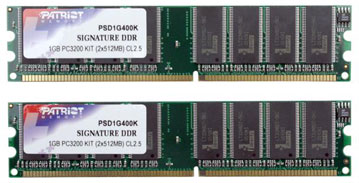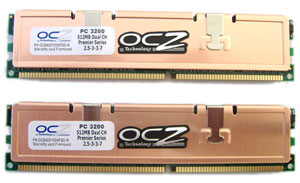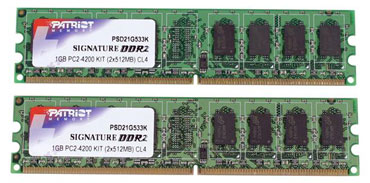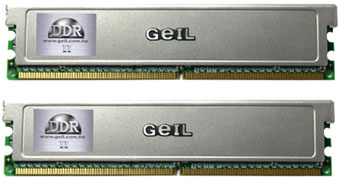Entry Level Buyer's Guide, October 2005
by Jarred Walton on October 14, 2005 12:05 AM EST- Posted in
- Guides
Memory Recommendations
We just took a look at several 1GB DIMM configurations. For the AMD socket 754 boards, it's important to remember that these are single channel memory controllers, so using two DIMMs won't help performance. Quite the opposite, in fact; some socket 754 motherboards will have problems operating two DIMMs at the fastest DDR400 speeds. We won't recommend using 2GB of RAM in a "budget" computer, but depending on price, it may be worthwhile to get 1x1GB instead of 2x512MB. It is important to note that the Intel configurations have differing RAM requirements. The office motherboard uses DDR memory, but we'll be using DDR2 for the gaming setup. Since we'll also get the benefit of dual-channel memory controllers on Intel, we chose 2x512MB packages for all the systems.
Office DDR Recommendation: Patriot Signature CL2.5 2x512MB
Price: $87 shipped (Retail)
We checked out prices on all the 1GB DIMMs in our RTPE and compared that with the prices of 2x512MB DIMMs. The difference in cost was only around $10, but generally speaking, the 512MB DIMMs had better timings for the same or lower price. (As we noted above, you would definitely want two DIMMs for the Intel Office system.) We've gone with the cheapest option, which ends up being the Patriot PC-3200 2x512MB Signature RAM. Rated at 2.5-4-4-8, the RAM isn't super fast, but the difference between this RAM and something a bit nicer like the Gaming RAM will in most instances be less than 5%. (You can likely run the RAM at 2.5-3-3-8 as well, though it's not guaranteed.) An extra $10 to $20 on every component adds up quickly, and we've tried to avoid going that route. For other alternatives, take a look at our "Gaming DDR RAM" recommendation below.
Gaming DDR Recommendation: OCZ Premier 2x512MB
Price: $95 shipped (Retail)
For the Gaming RAM, we wanted a bit more headroom for overclocking. Even though the lower memory ratios provide a lot of flexibility with Athlon 64/Sempron, it's still useful to be able to go above DDR400 speeds. We referenced our Value RAM Roundup as a guide - note that the OCZ Value VX/BH5 are no longer available without spending more money. For the best bang for the buck, the OCZ Premier at $95 is the most attractive upgrade. We managed to run this RAM at up to DDR480 with 2.5-3-3-8 timings (at 2.9V), so this should help out any overclocking attempts. CPU speed is generally king, but having a bit faster RAM is never a bad thing for performance.
Gaming DDR2 Recommendation: Patriot Signature PC-4200 2x512MB
Price: $74 shipped (Retail)
We've commented in a few other articles on the state of RAM prices, and DDR2 continues to drop. When you consider that you can get RAM capable of running up to DDR2-533 speeds for less than the cheapest DDR-400, the advantage of moving to DDR2 becomes clear. Yes, DDR2 generally has higher latency values than DDR, but there are a few architectural changes as well that make 4-4-4 DDR2 timings slightly faster than 4-4-4 DDR timings at the same clock speeds. The important thing is that getting DDR memory that can run at 533 MHz and above can cost almost twice as much as DDR2 RAM of the same speed. As with the Office DDR choice, we picked the most reasonably priced 2x512MB DDR2 offering that we could find, and once again, that was Patriot Signature. There are quite a few other manufacturers that make memory in this price range, but nearly all of them have the same specifications, and we might as well save $10. OCZ, Corsair, Mushkin, G.Skill, GEIL, and Crucial are all viable options, if you can't find Patriot RAM in your area.
Gaming DDR2 Alternative: GEIL PC-4200 2x512MB Value
Price: $86 shipped (Retail)
While technically no faster than the Office DDR2 RAM, we decided the extra $12 for the cool factor of the aluminum heat spreaders was a nice addition. (No, we don't mean "cool" as in temperatures - generally speaking, RAM heat spreaders don't actually help much.) G.Skill has some RAM with a yellow heat spreader if you're interested in more bling. Will the RAM run cooler or overclock better? Probably not, and the low CPU bus speed should make it a moot point. If you want the ability to push for even higher memory bandwidth, you could opt for some DDR2-667/PC2-5300 RAM instead. The cheapest qualifying RAM in that case also comes from GEIL, but costs $104. However, another $20 on a single component is hard to justify for this price segment.
Disclaimer: As we've said in the past, overclocking is not required. You may get an extra 20% or even 50% more CPU performance, but applications like games will often remain bottlenecked by the graphics card. For the hardcore enthusiast, overclocking can be a fun and cost-saving measure, but results are never guaranteed. If you need to ask how to overclock, you probably shouldn't do it (yet).
We just took a look at several 1GB DIMM configurations. For the AMD socket 754 boards, it's important to remember that these are single channel memory controllers, so using two DIMMs won't help performance. Quite the opposite, in fact; some socket 754 motherboards will have problems operating two DIMMs at the fastest DDR400 speeds. We won't recommend using 2GB of RAM in a "budget" computer, but depending on price, it may be worthwhile to get 1x1GB instead of 2x512MB. It is important to note that the Intel configurations have differing RAM requirements. The office motherboard uses DDR memory, but we'll be using DDR2 for the gaming setup. Since we'll also get the benefit of dual-channel memory controllers on Intel, we chose 2x512MB packages for all the systems.
Office DDR Recommendation: Patriot Signature CL2.5 2x512MB
Price: $87 shipped (Retail)
We checked out prices on all the 1GB DIMMs in our RTPE and compared that with the prices of 2x512MB DIMMs. The difference in cost was only around $10, but generally speaking, the 512MB DIMMs had better timings for the same or lower price. (As we noted above, you would definitely want two DIMMs for the Intel Office system.) We've gone with the cheapest option, which ends up being the Patriot PC-3200 2x512MB Signature RAM. Rated at 2.5-4-4-8, the RAM isn't super fast, but the difference between this RAM and something a bit nicer like the Gaming RAM will in most instances be less than 5%. (You can likely run the RAM at 2.5-3-3-8 as well, though it's not guaranteed.) An extra $10 to $20 on every component adds up quickly, and we've tried to avoid going that route. For other alternatives, take a look at our "Gaming DDR RAM" recommendation below.
Gaming DDR Recommendation: OCZ Premier 2x512MB
Price: $95 shipped (Retail)
For the Gaming RAM, we wanted a bit more headroom for overclocking. Even though the lower memory ratios provide a lot of flexibility with Athlon 64/Sempron, it's still useful to be able to go above DDR400 speeds. We referenced our Value RAM Roundup as a guide - note that the OCZ Value VX/BH5 are no longer available without spending more money. For the best bang for the buck, the OCZ Premier at $95 is the most attractive upgrade. We managed to run this RAM at up to DDR480 with 2.5-3-3-8 timings (at 2.9V), so this should help out any overclocking attempts. CPU speed is generally king, but having a bit faster RAM is never a bad thing for performance.
Gaming DDR2 Recommendation: Patriot Signature PC-4200 2x512MB
Price: $74 shipped (Retail)
We've commented in a few other articles on the state of RAM prices, and DDR2 continues to drop. When you consider that you can get RAM capable of running up to DDR2-533 speeds for less than the cheapest DDR-400, the advantage of moving to DDR2 becomes clear. Yes, DDR2 generally has higher latency values than DDR, but there are a few architectural changes as well that make 4-4-4 DDR2 timings slightly faster than 4-4-4 DDR timings at the same clock speeds. The important thing is that getting DDR memory that can run at 533 MHz and above can cost almost twice as much as DDR2 RAM of the same speed. As with the Office DDR choice, we picked the most reasonably priced 2x512MB DDR2 offering that we could find, and once again, that was Patriot Signature. There are quite a few other manufacturers that make memory in this price range, but nearly all of them have the same specifications, and we might as well save $10. OCZ, Corsair, Mushkin, G.Skill, GEIL, and Crucial are all viable options, if you can't find Patriot RAM in your area.
Gaming DDR2 Alternative: GEIL PC-4200 2x512MB Value
Price: $86 shipped (Retail)
While technically no faster than the Office DDR2 RAM, we decided the extra $12 for the cool factor of the aluminum heat spreaders was a nice addition. (No, we don't mean "cool" as in temperatures - generally speaking, RAM heat spreaders don't actually help much.) G.Skill has some RAM with a yellow heat spreader if you're interested in more bling. Will the RAM run cooler or overclock better? Probably not, and the low CPU bus speed should make it a moot point. If you want the ability to push for even higher memory bandwidth, you could opt for some DDR2-667/PC2-5300 RAM instead. The cheapest qualifying RAM in that case also comes from GEIL, but costs $104. However, another $20 on a single component is hard to justify for this price segment.
Disclaimer: As we've said in the past, overclocking is not required. You may get an extra 20% or even 50% more CPU performance, but applications like games will often remain bottlenecked by the graphics card. For the hardcore enthusiast, overclocking can be a fun and cost-saving measure, but results are never guaranteed. If you need to ask how to overclock, you probably shouldn't do it (yet).














35 Comments
View All Comments
i am getting angry - Friday, October 14, 2005 - link
As most of you known, I'm usually a big fan of Anandtech, however this time I couldn't disagree more!A "cheap/no name/ POS" PSU is an open inventation to every problem possible!
Very good PSU's can be had for under $30!
Cheap, but Good PSU's! [url]http://www.hardforum.com/showpost.php?p=1027898523...[/url]
I am "davidhammock200" however I couldn't login as me!
JarredWalton - Friday, October 14, 2005 - link
"A 'cheap/no name/POS' PSU is an open inventation to every problem possible!"It depends a lot on how high-end you go with parts. I've got a system sitting two feet from me with that MGE case and PSU. It's running at 2.70 GHz with a Sempron 3100+, and it's been running that way for three months. Did I get lucky? Maybe. More likely, people are just a little too concerned about power supplies and budget systems. $30 more would be enough to upgrade the 19" CRT to a 17" LCD - which do you think most people will choose?
I personally have never encountered instability that I would attribute to a PSU. I've had PSUs fail on numerous occasions, but in every case all it required was a new PSU. I've heard the stories of PSUs taking out the entire computer, and it's certainly possible in theory. I've never actually seen it happen, though.
Maybe I just care for my PCs too well? I do try to give them a good dusting every 3 months, which does wonders for fan life. I also don't try putting high-end builds with low end power. Low end parts with a low end PSU is exactly what you get from Dell and the likes, though. I've got a P4 2.8C Dell at my corporate job that has a 150W PSU. Amazing, eh? And it's been running 24/7 for over two years.
bldckstark - Friday, October 14, 2005 - link
If you want to get PO's about an article take a look at this one that is posted on THG. This is the most ridiculous thing I have ever read. They put together a MAJOR POS, don't use any logic, then also don't have any benchmarks to show what a piece it is. Take a look @ http://www.tomshardware.com/howto/20051014/index.h...">$500 gaming rig from THGYou may disagree with some of the picks here, but that whole system is crap. But at least they stayed in budget! I used to love THG, but now it is ridiculous. They have become a system buyer site, instead of a system builder site. It's like PCWorld bought them or something.
If you were going to build a system for $750, and you found you could build a significantly better one for $100 more wouldn't you do it? Hell, that is only 13%. I recently did the exact same thing. I got an SLI board cuz it was only $20 more. I got a 3200+ on a deal cuz it was only $15 more than the 3000+ on a package deal. I got a 6600GT even though they cost more than I originally thought. I got 512MB OCZ Platinum Rev2 ram cuz I can buy more later instead of 1GB of value ram now. I got a 300GB SATA drive cuz it was cheaper per GB than a 250, but it cost more too. Any project of any kind should have built in 10% contingency plan. In my lonely opinion Jarred is only liable for grief on the 3% over that. So here it is WAAaa.......... (3% of a whine).
bgladwyn - Friday, October 14, 2005 - link
It seems odd to include a speaker package with a subwoofer for an office setup when headphones would do. Similarly, flat panels are useful in the office because of the desk space they liberate. Lose the $37 speakers and shell out $199 for the cheapest 17" TFT on PriceGrabber and you have $33 well spent.JarredWalton - Friday, October 14, 2005 - link
When I say office in this guide, I mean "home office" as opposed to an actual workplace computer. For a workplace, speakers are generally frowned upon. There are many ways to get to an LCD, but quality is a bit more important than price if you're going that route. I'd forget about 15" LCDs and put 17" as the minimum, with a DVI input being preferred. Still, $200 for a 17" LCD isn't bad. $250 will even get you a 19" model, possibly with DVI.Like I said in the displays section, the only reason I didn't include an LCD was to get closer to the $500 price. I highly recommend anyone that can should spend more money on the display, with 19" LCDs being the ultimate goal.
bgladwyn - Friday, October 14, 2005 - link
Fair play, I've read all the article now(!) and can see that you'd already considered this point.ceefka - Friday, October 14, 2005 - link
Any expectations on integrated DVI graphics?I think that a 17" VGA LCD like the Samsung 710v (think it was 12 or 16ms) is quite OK for office use. Granted it is more expensive than a "comparable" CRT. It uses less juice, produces less heat and occupies less space, plus you actually work on that screen. My latest experience on a CRT was that after some time the numbers danced before my very eyes :D Just weigh that in and draw your own conclusions.
pcmatt1024 - Saturday, October 15, 2005 - link
i believe the new 6150 from nvidia (basically the higher end version of what was used on the amd office board) will have dvi out. boards should be out in the next few weeks.
JarredWalton - Saturday, October 15, 2005 - link
I can say for sure that the ATI Xpress 200 and Intel 915G both *can* support DVI output. The problem is that no motherboard manufacturers actually have such support so far. (I know that it's possible because I have two SFF cases with those chipsets, and they both have DVI ports.) Basically, DVI is a "high-end" option and IGP is often "value-oriented". It's sort of like the problem with uATX motherboards: no one makes an "enthusiast uATX" design; they're all built for value. And yes, there are some people that would like a high quality uATX mobo.PrinceGaz - Friday, October 14, 2005 - link
LCD panels are certainly getting better and I know for a fact that my next display (when this Mitsubishi DP 2070SB fails, which hopefully won't be for several years) won't be a CRT as there is already nothing available as good as it.If you were having problems using a CRT, then the refresh-rate was almost certainly too low. Windows 2000/XP defaults to 60hz which is unusable for most people for extended periods with a CRT monitor, and that is probably what you were using. Any half-decent CRT monitor will support at least 85hz at the ideal resolution, with which most people have no problems. Really good CRT monitors will support 100hz or more at their optimum resolutions, but unfortunately those really good CRT monitors can only be bought second-hand now as all the best manufacturers have switched to LCD panels.